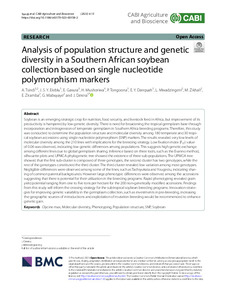| dc.contributor.author | Tsindi, A. |
| dc.contributor.author | Eleblu, J.S.Y. |
| dc.contributor.author | Gasura, E. |
| dc.contributor.author | Mushoriwa, H. |
| dc.contributor.author | Tongoona, P. |
| dc.contributor.author | Danquah, E. |
| dc.contributor.author | Mwadzingeni, L. |
| dc.contributor.author | Zikhali, M. |
| dc.contributor.author | Ziramba, E. |
| dc.contributor.author | Mabuyaye, G. |
| dc.contributor.author | Derera, J. |
| dc.date.accessioned | 2023-07-04T15:01:15Z |
| dc.date.available | 2023-07-04T15:01:15Z |
| dc.date.issued | 2023 |
| dc.identifier.citation | Tsindi, A., Eleblu, J.S.Y., Gasura, E., Mushoriwa, H., Tongoona, P., Danquah, E., ... & Derera, J. (2023). Analysis of population structure and genetic diversity in a Southern African soybean collection based on single nucleotide polymorphism markers. CABI Agriculture and Bioscience, 4(1): 15, 1-14. |
| dc.identifier.issn | 2662-4044 |
| dc.identifier.uri | https://hdl.handle.net/20.500.12478/8225 |
| dc.description.abstract | Soybean is an emerging strategic crop for nutrition, food security, and livestock feed in Africa, but improvement of its productivity is hampered by low genetic diversity. There is need for broadening the tropical germplasm base through incorporation and introgression of temperate germplasm in Southern Africa breeding programs. Therefore, this study was conducted to determine the population structure and molecular diversity among 180 temperate and 30 tropical soybean accessions using single nucleotide polymorphism (SNP) markers. The results revealed very low levels of molecular diversity among the 210 lines with implications for the breeding strategy. Low fixation index (FST) value of 0.06 was observed, indicating low genetic differences among populations. This suggests high genetic exchange among different lines due to global germplasm sharing. Inference based on three tools, such as the Evanno method, silhouette plots and UPMGA phylogenetic tree showed the existence of three sub-populations. The UPMGA tree showed that the first sub-cluster is composed of three genotypes, the second cluster has two genotypes, while the rest of the genotypes constituted the third cluster. The third cluster revealed low variation among most genotypes. Negligible differences were observed among some of the lines, such as Tachiyukata and Yougestu, indicating sharing of common parental backgrounds. However large phenotypic differences were observed among the accessions suggesting that there is potential for their utilization in the breeding programs. Rapid phenotyping revealed grain yield potential ranging from one to five tons per hectare for the 200 non-genetically modified accessions. Findings from this study will inform the crossing strategy for the subtropical soybean breeding programs. Innovation strategies for improving genetic variability in the germplasm collection, such as investments in pre-breeding, increasing the geographic sources of introductions and exploitation of mutation breeding would be recommended to enhance genetic gain. |
| dc.description.sponsorship | German Academic Exchange Service |
| dc.format.extent | 1-14 |
| dc.language.iso | en |
| dc.subject | Glycine Max |
| dc.subject | Biodiversity |
| dc.subject | Phenotyping |
| dc.subject | Population Structure |
| dc.subject | Single Nucleotide Polymorphism |
| dc.subject | Grain Legumes |
| dc.subject | Soybeans |
| dc.title | Analysis of population structure and genetic diversity in a Southern African soybean collection based on single nucleotide polymorphism markers |
| dc.type | Journal Article |
| cg.contributor.crp | Grain Legumes |
| cg.contributor.affiliation | University of Ghana |
| cg.contributor.affiliation | University of Zimbabwe |
| cg.contributor.affiliation | International Crops Research Institute for the Semi-Arid Tropics |
| cg.contributor.affiliation | Seed Co Limited, Rattray Arnold Research Station, Zimbabwe |
| cg.contributor.affiliation | International Institute of Tropical Agriculture |
| cg.coverage.region | Africa |
| cg.coverage.region | Southern Africa |
| cg.coverage.country | Zimbabwe |
| cg.coverage.hub | Headquarters and Western Africa Hub |
| cg.researchtheme | Biotech and Plant Breeding |
| cg.identifier.bibtexciteid | TSINDI:2023 |
| cg.isijournal | ISI Journal |
| cg.authorship.types | CGIAR and developing country institute |
| cg.iitasubject | Agronomy |
| cg.iitasubject | Biodiversity |
| cg.iitasubject | Food Security |
| cg.iitasubject | Grain Legumes |
| cg.iitasubject | Plant Breeding |
| cg.iitasubject | Plant Production |
| cg.iitasubject | Soybean |
| cg.journal | CABI Agriculture and Bioscience |
| cg.notes | Open Access Journal; Published online: 30 May 2023 |
| cg.accessibilitystatus | Open Access |
| cg.reviewstatus | Peer Review |
| cg.usagerightslicense | Creative Commons Attribution 4.0 (CC BY 0.0) |
| cg.targetaudience | Scientists |
| cg.identifier.doi | https://doi.org/10.1186/s43170-023-00158-2 |
| cg.iitaauthor.identifier | John Derera: 0000-0003-3715-0689 |
| cg.futureupdate.required | No |
| cg.identifier.issue | 1: 15 |
| cg.identifier.volume | 4 |

